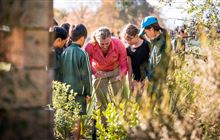Nature sensory bingo
Introduction
A series of bingo ideas to keep learning in nature.View and download the activity in English or Te Reo Māori.
Nature sensory bingo
Mā te ako ka mōhio, mā te mōhio kā mārama, mā te mārama ka mātatau.
Through learning we know, by knowing we understand, by understanding we are confident.
Nature sensory bingo activity card (PDF, 1,087K)
Plant sensory bingo card (PDF, 133K)
Activity
Colour and shape bingo
Create a simple bingo sheet with different colours or shapes. Leave some blank spaces for discoveries.
Take your bingo sheets outside and record what colours/shapes you find.
Can you find anything surprising? Different? Unusual? Repeated?
Cloud bingo
Create a simple bingo sheet with various shapes or objects.
Lie down and observe the sky.
Use your imagination to find shapes/objects/creatures in the clouds.
Plant sensory bingo
Download and print the plant sensory bingo card (PDF, 133K), or create your own.
Take bingo sheets outside and in groups, pairs or individually, explore and record what you find.
Encourage tamariki to collect individual leaves, flowers or seeds if appropriate to do so.
Use your senses – what do the plants and leaves look, smell and feel like? Avoid tasting.
Curriculum Links
English
- Use the items found during the colour bingo activity as prompts to create a colour poem.
- What one word best describes an item you found? (Choose your most interesting five items.)
- Find synonyms to describe the things you found in different ways.
- Collate your nature words and create a class nature word bank.
Science – living world
- Look at the Te Reo Taio booklet.
- Categorise your treasures according to characteristics (eg living and non-living).
- Examine your classmate’s items. Discuss what you could predict about your outdoor space from the collection of objects (Are there many native plants? What animals/birds/insects might live in and around these objects? How would they use them or benefit from them?)
Mathematics and statistics – geometry and measurement
- Draw and describe attributes of the shapes you found in your outdoor space (eg sides, corners, curved and straight lines, edges, pointed).
- Do you see any ways that these shapes that are alike? How are they alike?
- Can you see any shapes that are different? How are they different?
- What do these shapes have in common? Are all the sides the same? Are all the corners the same?
- Using the items collected, investigate examples of patterns and symmetry in nature (eg a daisy flower is a good example of rotational symmetry).
- Use photos of the items found during your bingo activities and mirrors to investigate reflection symmetry.
- Sort items collected by size, colour, shape, texture, weight.
Health and physical education
- Investigate the role of plants for our body’s health – as a source of nutrition and fuel, as well as medicinal/rongoā qualities.
- Make this activity into an amazing race/scavenger hunt. Who found the most/unique/biggest/smallest items?
The arts
- Create artwork to depict the nature you saw, touched, heard and smelt.
- Create leaf rubbings.
- Use photos of the items found during your nature bingo activities to create a collage of the shapes and/or colours found in your outdoor space.
- Use the items found during your nature bingo activities as inspiration to draw nature patterns and shapes.
Kēmu wharewhare taiao
Mā te ako ka mōhio, mā te mōhio kā mārama, mā te mārama ka mātatau.
Kēmu wharewhare taiao (PDF, 1,079K)
Ngohe
Whareware ā-tae, ā-āhua
Hangaia he whārangi wharewhare, kia rerekē ngā tae, me ngā āhua. Waihotia ētahi wāhanga mō ngā kitenge hou.
Haria tāu whārangi wharewhare ki waho, ka whakakīhia ngā wāhanga ki ngā tūmomo tae, me ngā āhua kitea ai koe.
He aha ngā mea mīharo? rerekē? Ōrite? i kitea e koe.
Wharewhare kapua
Hangaia he whārangi wharewhare, kia rerekē ngā tae, me ngā āhua.
Takoto ka mātirotiro ki te rangi.
Tukuna mā ōu whakaaro e hanga kōrero pohewa mā te mātaki i ngā āhua o ngā kapua.
Wharewhare taironga tipu
Tikiake i tēnei rauemi plant sensory bingo card (PDF, 133K) hangaia tāu ake.
Haria ngā whārangi wharewhare ki waho, hei mahinga takitahi, takirua, takiroopu rānei. Torotoro tu, rīkoatatia āu/ ā koutou kitenga. Whakatenatena i ngā tamariki kia kohikohi rau, putiputi, kākano hoki.
Whakamahia ōu tairongo – kapo ake he tipu he rau hoki (kaua e kai).
Curriculum links
Reo
- Whakamahia ngā rauemi i kohikohia kia hanga he rotarota tae.
- He aha tētahi kotahi hei whakamārama i āu kitenga, mai ngā taonga e rima e mīharo ana ki a koe?
- Kimihia ngā whārite hei whakamārama i ngā mea i kitea e koe.
- Kohikohia āu kupu o te taiao hei hanga punga kupu.
Pūtaiao
- Te Reo Taio booklet
- Wherawhera i āu taonga ki a rātau roopu (ora – mate rānei)
- Āta titiro ki ngā pikitia/whakaahua o tōu hoa. Matapakihia āu matapae mō taua wāhi taiao o roto i ngā whakaahua kua hopukina. (Ko tēhea ngā tipu, taketake ki Aoteroa nei/kai/Rongoa/whakauruhia? He aha ngā kararehe/manu/ngārara e noho ana ki ēnei tūmomo tipu? Ka pēhea rātau e whakamahi hei painga?
Pangarau
- Tā / whakamāramatia ngā huanga o ngā mea i kimihia e koe ki waho. (ngā taha, ngā kokonga, nga huringa, ngā rārangi, ngā tapa hoki).
- Kei te kitea he ōritetanga? He aha ngā ōritetanga?
- Kei te kitea he rerekētanga? He aha ngā rerekētanga?
- He aha ngā tūāhuatanga tino ōrite o ēnei kitenga?
- He ōrite katoa ngā taha, ngā tapa me ngā kokonga?
- Mā te whakamahi i ngā kohinga o te taiao, āta tirohia ngā āhua, ngā ōritenga hoki. (Hei tauira te porohitatanga o ngā putiputi).
- Whakamahia ngā whakaahua ka tirohia ngā hangaritetanga o ngā rahi, ngā tae, ngā āhua me ngā taumaha.
Hauora
- Rangahautia ngā oranga o ngā tipu mō tō mātau tinana, he aha ēnei āhuatanga whakaora?
- Hangaia he ngoe ‘rapu ka kimi’. Ko wai i kitea ngā mea nui ake, iti iho, mīharo rawa?
Ngā Toi
- Waihanga he mahinga toi e whakaatu ana tāu i kitea ai, i pā ai, i rongo ai hoki.
- Hangaia he miringa rau.
- Whakamahia whakaahua o ngā mea i kimihia e koe i te taiao ka hanga he whakaaturanga toirau o ngā tūmomo tae, āhua o taua wāhanga o te taiao.
- Whakamahia whakaahua o ngā mea i kimihia e koe i te taiao ka tā pikitia o te taiao.



